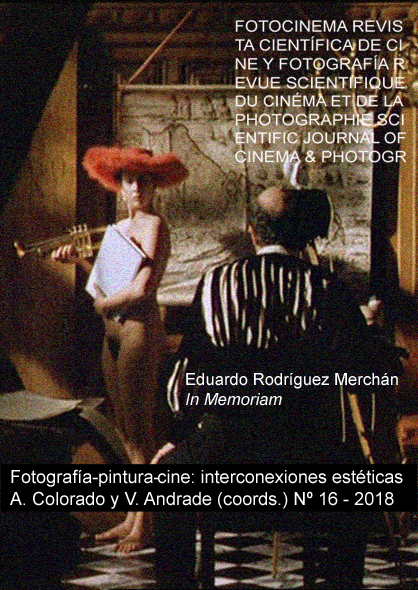The pictorial influence in the spatial representation of the cinema of the origins. The off-sreen relation from the cinema of Georges Méliès
DOI:
https://doi.org/10.24310/Fotocinema.2018.v0i16.4085Keywords:
Cinema and Painting, Space, Off-screen, Early CinemaAbstract
The influence of painting in the cinematographic image has been constant since the apparition of cinema until our days. This influence was, undoubtedly, more evident in early cinema, where the conception of space was absolutely linked with the idea of a painting, limiting the films’ posibilities and making their space limited and static. Although this pictorical heritage, during the first years of cinema, the use of the off-screen was generalized and, inspite of the limited posibilities of this early off-screen, it started to open the limits of the screen, anticipating the unlimited space in modern cinema. Georges Méliès was the best example of the idea of the film as a painting, but, also, used the off-screen so often, that he became one of the pioneers in the use of the absent space, anticipating the dinamism of modern cinema.
Downloads
Metrics
Publication Facts
Reviewer profiles N/A
Author statements
Indexed in
-
—
- Academic society
- N/A
- Publisher
- Universidad de Málaga
References
Aumont, J. (1997). El ojo interminable. Cine y pintura. Buenos Aires: Paidós.
Bonitzer, P. (2007). Desencuadres. Cine y pintura. Buenos Aires: Santiago Marcos.
Burch, N. (2016). El tragaluz del infinito. Madrid: Cátedra.
Burch, N. (2008). Praxis del cine. Madrid: Fundamentos.
Deleuze, G. (1984) La imagen-movimiento. Barcelona: Paidós.
Durand, P. (1993). Cinéma et montage: un arte de l'ellipse. París: Éditions du Cherf.
Gómez Tarín, F. J. (2006). Más allá de las sombras. Lo ausente en el discurso fílmico desde los orígenes hasta el declive del clasicismo (1895-1949). Castellón: Universitat Jaume I.
Méliès, G. (1930). Les vues cinématographiques. Le Nouvel Art Cinématographique, 5 (2ª serie).
Sadoul, G. (1964). Louis Lumière. París: Seghers.
Downloads
Published
How to Cite
Issue
Section
License
All contents published in Fotocinema Revista científica de cine y fotografía are protected under the Creative Commons Attribution-NonCommercial-ShareAlike 4.0 International (CC BY-NC-SA 4.0) license. All about this license is available in the following link: <http://creativecommons.org/licenses/by-nc-sa/4.0>
Users can copy, use, redistribute, share and exhibit publicly as long as:
- The original source and authorship of the material are cited (Journal, Publisher and URL of the work).
- It is not used for comercial purposes.
- The existence of the license and its especifications are mentioned.
There are two sets of authors’ rights: moral and property rights. Moral rights are perpetual prerogatives, unrenounceable, not-transferable, unalienable, imprescriptible and inembargable. According to authors’ rights legislation, Fotocinema. Revista científica de cine y fotografía recognizes and respects authors moral rights, as well as the ownership of property rights, which will be transferred to University of Malaga in open access. The property rights are referred to the benefits that are gained by the use or the dissemination of works. Fotocinema. Revista científica de cine y fotografía is published in an open access form and it is exclusively licenced by any means for doing or authorising distribution, dissemination, reproduction, , adaptation, translation or arrangement of works.
Authors are responsable for obtaining the necessary permission to use copyrighted images.














13.png)



